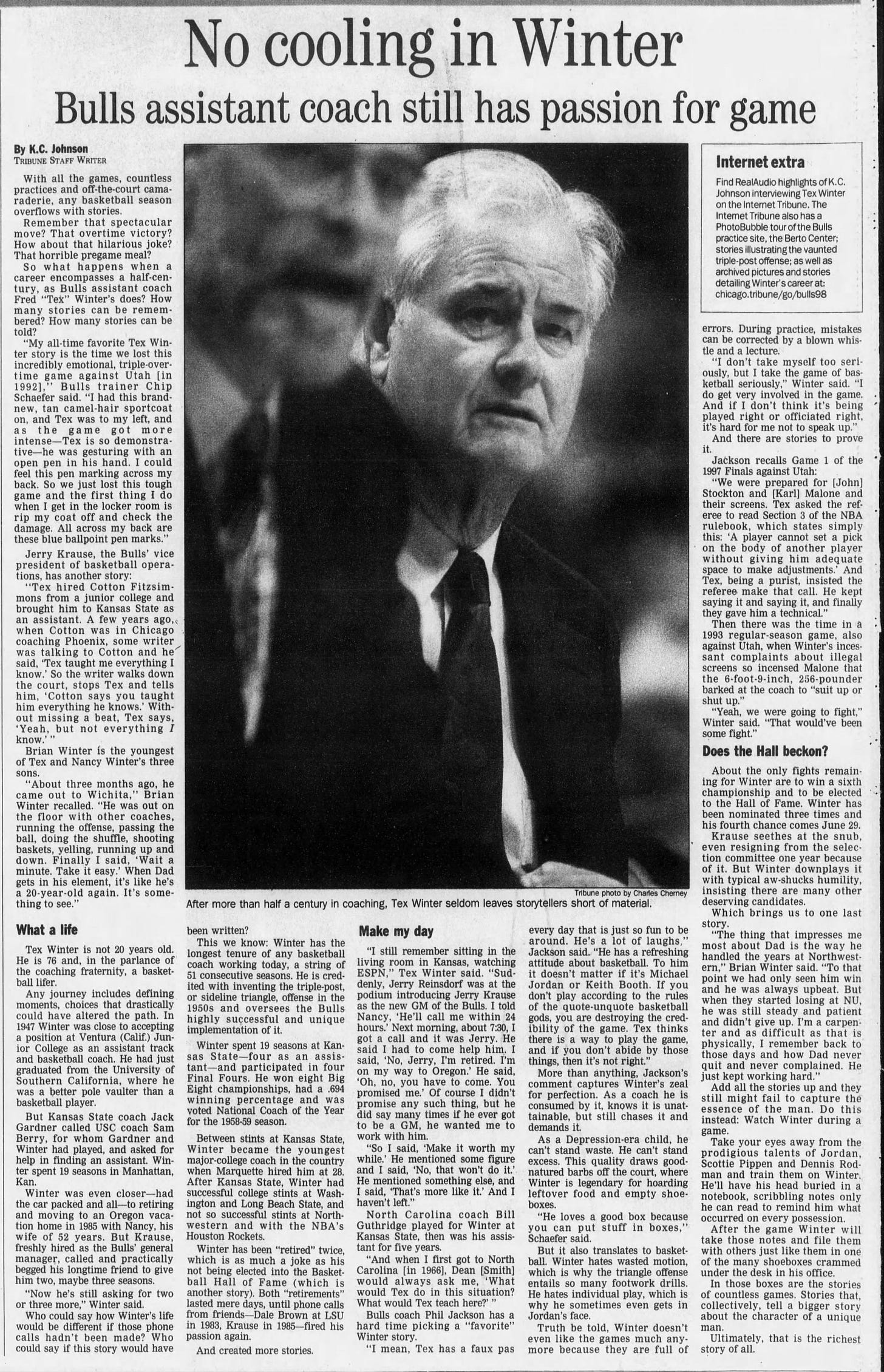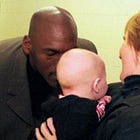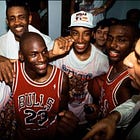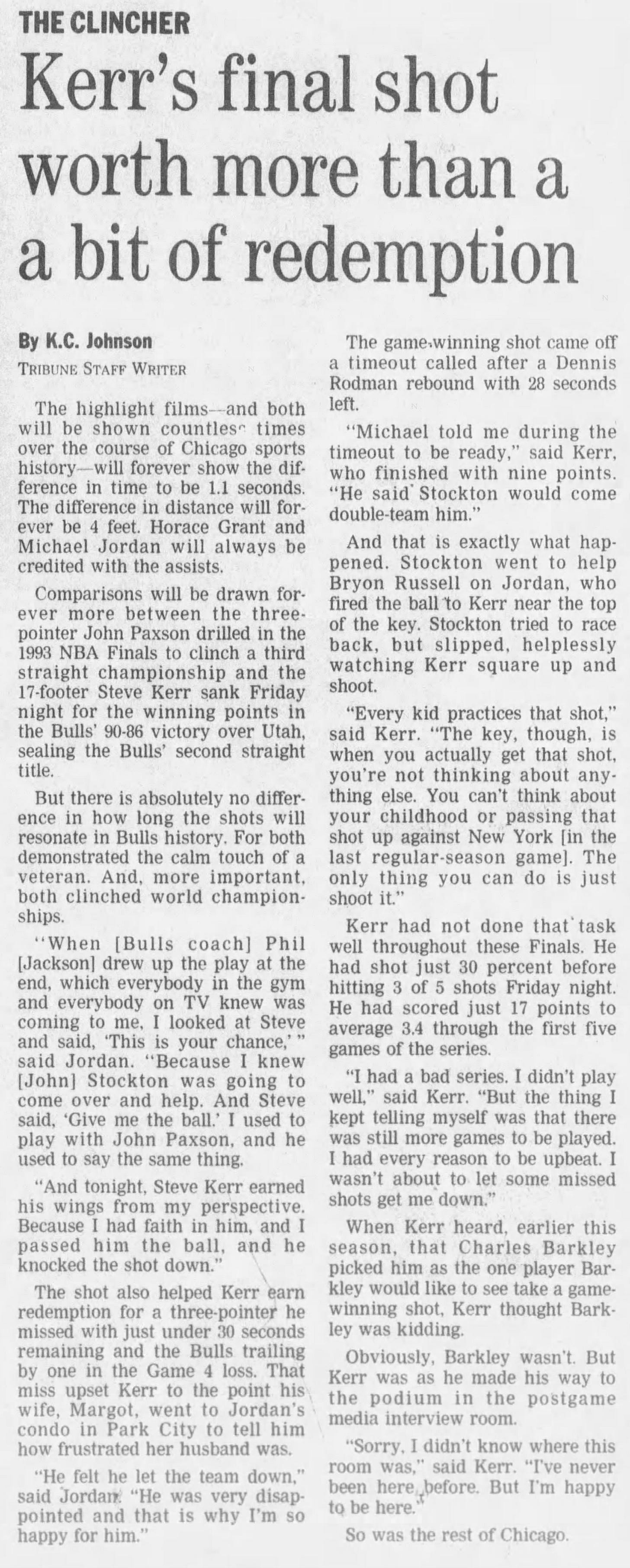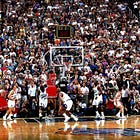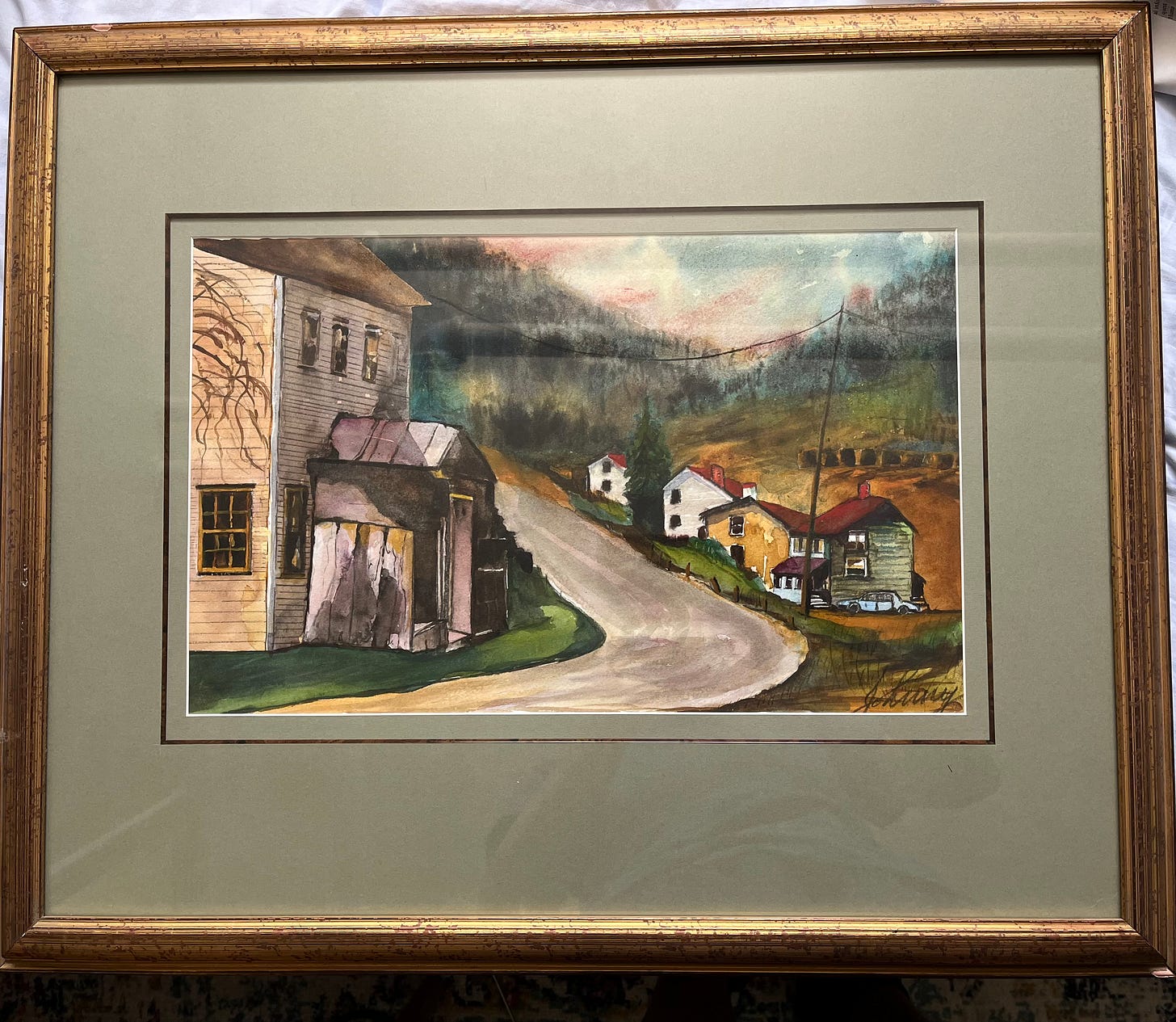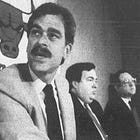"Reporting live from the United Center" — An interview with K.C. Johnson
From ball boy for MJ to Johnny Bach's watercolors, K.C.'s career hits the high marks.

In the fall of 1985, when K.C. Johnson was a freshman basketball player at Beloit College, the Bulls held training camp at Beloit, with the Beloit players serving as ball boys for a team that included reigning Rookie of the Year Michael Jordan.
Like any hoops fan, not to mention any young player, K.C. was ecstatic. But when he thought of his future profession, he wasn’t thinking about Jordan.
“To show you how twisted I was, my eyes were on Bob Sakamoto, the Tribune’s beat writer, as much as they were on Michael Jordan,” he says now. “Because I knew I wanted to be a Bulls beat writer for the Chicago Tribune.”
K.C. made it, and ended up covering Michael Jordan and the Bulls, especially during the second three-peat. In the “last dance” season of 1998, K.C.’s assignment at the Trib was simple: cover MJ.
In this interview, K.C. discusses growing up a Bulls fan in Evanston, getting opportunities at the Tribune on their new innovation called a website, and shares stories of MJ in the 80s, MJ in the 90s, Phil Jackson getting fined by the NBA for a bizarre reason, Steve Kerr, the Tribune’s Terry Armour, Tex Winter, Jerry Krause, Bulls PR man Tim Hallam and the great Johnny Bach, whose watercolor paintings were so striking that K.C. has one.
This interview has been edited for length and clarity. Also note that, while this did not come up during the interview, this interview was conducted in July 2024, when K.C. was at NBC Sports Chicago, prior to the launch of CHSN, where he now works.
All newspaper clips from newspapers.com.
As a fellow Evanston man, and as a basketball player, what were your earliest memories of watching the Bulls?
My family was not that well off, but every once in a while we’d grab some standing-room tickets and get down to Chicago Stadium. I remember the Dick Motta teams, and I was pretty lucky to know I wanted to get into journalism at a remarkably young age. So I was reading the Chicago Tribune and guys like Bob Logan, Cooper Rollow, and their Bulls coverage back in the 70s as a kid growing up in Evanston.
Those teams connected with the city because they fit the profile or identity of the city: blue collar, hard-working, gritty, tough, defensive-minded. Those are my earliest memories of going to Chicago Stadium if we were lucky enough, but otherwise consuming coverage of the Bulls in the Chicago Tribune.
What do you think was your first year going to a Bulls game?
It was the ‘75-’76 season. That was definitely my first one. So I’m old. (Laughs.)
I’ve read about what Pat Williams, rest in peace1, brought into the Stadium, and I saw an article that the year before he came there was a game with just 741 fans. What were Bulls games like then?
Smokey, (laughs) because everybody smoked. And we were up in the 300 level in the standing-room-only. So that’s my dominant memory as a kid: the cigarette smoke.
They were already pretty well established and successful — they were drawing by the time I was going to games. And I’m a very young kid then. I’m eight years old, nine years old. And we didn’t go a lot. It was a big treat when my dad would take me. I think I went to two, maybe three games in person?
The game I went to, we were up in standing-room-only. Like I said, it was smokey and loud. As a kid, you’re in awe of that stuff. It’s like the first time you go to Wrigley. You’re just soaking it all in.
You wrote a story in 2020 — the link is broken but I saw some of it — about when you were at Beloit your freshman year, and the Bulls practiced at your facility or your gym?
They didn’t practice — they had training camp there!
Training camp. Wow. So that was ‘86?
Eighty-five. Training camp of ‘85. I was a freshman. I graduated from Evanston Township High School in the spring of ‘85, and then I enrolled at Beloit College in the fall of 1985 as a freshman basketball player. The Bulls under Stan Albeck held their training camp at our facility. We actually at the time had one of the best facilities in the entire country because it was an Old Barn-type atmosphere where the springy floor was raised, and Stan Albeck had a relationship with our Division III coach Bill Knapton2 who was kind of a legend in Division III basketball. So the Bulls decided to hold training camp there because of the facilities and because of that connection.
As basketball players, we got to be ball boys for the training camp, which was obviously a ridiculously amazing experience. But to show you how twisted I was, my eyes were on Bob Sakamoto, the Tribune’s beat writer, as much as they were on Michael Jordan. Because I knew I wanted to be a Bulls beat writer for the Chicago Tribune. I was going in for Bob Sakamoto’s job even back then.
It was Jordan’s second year. It was shortly before he broke the bone in his foot. I actually can find this picture on my phone that I’ll pull up for you while we’re talking. Simpler time. It’s Jordan, no entourage, no bodyguards. Just him right there with you, in the back of a convertible pulling in to the football stadium to the coin toss for a game. It was right before Air Jordans were blowing up. That was obviously an amazing experience.
That is so cool. Any memories of the other players? George Gervin? Rookie Charles Oakley?
I had strong memories of Quintin Dailey because it was fairly controversial. He was obviously a polarizing figure3. I remember a free throw contest that Jordan and Dailey were having post-practice. This kind of gives you a window into Jordan’s now stereotypical manic mindset, but it started out jovial and fun. Just good natured smack talking.
And then Quintin Dailey started winning, and all of a sudden you saw this switch flip for Michael and how serious he got. Just a post-practice free throw shooting contest and his desire to win at all costs. I distinctly remember watching that as an 18-year-old kid.
You knew you wanted to be Bob Sakamoto or Cooper Rollow or Bob Logan. I saw that you were doing Trib Bulls coverage during the ‘91 Finals. It might not have been in the locker room. For example, you had a story where you interviewed all of the 70s guys.
What were your early Tribune duties? When were you actually on the beat?
I started at the Tribune in the fall of 1990 as a part-time employee covering high school sports, and my job was to answer phones. This is obviously a completely different era where newspapers ruled the world and all the area high school coaches would call in their scores to the Tribune. “Hi, this is Glenbrook South women’s soccer varsity coach. I’m calling in our 2-1 victory over Fremd. Here’s who scored, here are the highlights,” and you’d write this down on a piece of paper and then type it into the computer system and we turn it into a paragraph highlight in the newspaper.
It’s a completely different era. That was my job. It was really menial and kind of boring but I was inside the Chicago Tribune as a 22-year-old and it was like my PhD in journalism. I was getting to watch great writers and great editors and see the paper get put out.
That story you’re referring to was me just pitching ideas. I was constantly trying to make myself more valuable because I knew I wanted to get into writing and cover the NBA. I had a lot of those guys’ phone numbers because I had done something on my own on a freelance basis where I got a hold of Chet Walker, Bob Love, Norm Van Lier. I had their phone numbers. So I pitched that to the Trib and they accepted it.
My first big break came in 1996 in the second three-peat. This little thing called the internet came along, which shows how old I am, and we realized how big the Bulls were and that there was more demand than just what would appear in the newspaper. We had this new thing called the World Wide Web to feed, and so they gave me the assignment to cover the Bulls for the startup www.chicagotribune.com website.
So I got to cover the Bulls through the internet, and what’s hilarious is now obviously the internet rules the world and newspapers are the afterthought, but back then the newspapers ruled the world and the internet was the afterthought.
I took that opportunity and ran with it. I was 29 and I couldn’t believe I was getting to cover a historic team for a startup website. I went to every practice, every game. I didn’t travel because I wasn’t the main beat writer for the newspaper but I did travel during the playoffs. That was when I first started being around the Bulls full time in ‘96.
What was your “Welcome to the Bulls beat” moment? You can define that however you want.
I’ve never been asked that one. That’s a good one. I had a great mentor. Terry Armor was the main beat writer for the Tribune. The late-great, a very close friend of mine. We lived very close to each other on the north side. We drove to practice there every day, go out for drinks after games. He really took me under his wing.
My “Welcome to the NBA” moment was probably just being around Jordan, because at that time other than my experience around him as a ball boy at Beloit College, he was so big that he had an aura about him. As a young journalist, it was the first time where I had to really remove myself from being in awe of an athlete and focus on the job. It was a huge assignment that was given to me. I was young and kind of green and I had to realize, okay, that’s Michael Jordan, but you’ve got to treat him like anybody else. It took me a while to get over that.
That was a good education for me and that was probably my “Welcome to the NBA” moment.
Sam Smith and Cheryl Raye-Stout and Fred Mitchell have talked about how Jordan changed interacting with the media from before his first retirement to after he came back from baseball. You obviously were only working with him from that point. They talk about how he used to always just sit and rap with everybody for 45 minutes, and then that started to tighten up and shrink.
How was Jordan as an interview subject in that second three-peat?
That’s a great point because I’ve heard those same stories. I was around the media world, even though I wasn’t covering the Bulls, so I knew that he really enjoyed that give and take. It was more just casual and loose and you could really get to him. What I would say about the second three-peat is even though he was starting to explode and becoming the mythic figure on par with Muhammad Ali or Pele or any of those all-time greats, you could tell he still really enjoyed the process. He was very thoughtful with his answers. He contemplated good questions. I thought he was a fantastic interviewee and I thought he gave great quotes.
I thought he was a student in the game. I thought he obviously saw the game at a genius-type level, and I thought there was really still great back and forth.
But yes, in the three years I was around him, the ‘96, ‘97, ‘98 seasons, I never had a one-on-one with him. That is a huge difference from what the people you’re mentioning — Sam and Cheryl and others — from their experiences because there was always such a throng around him it was hard to get to him. But I thought that he was fantastic.
By the time we get to the ‘98 Finals, my assignment for the Tribune was not to cover the Bulls but to cover Michael Jordan. I wrote Michael Jordan every day in ‘97-’98. That was my beat: Michael Jordan. And even still I didn't get a one-on-one (laughs), so that tells you all you need to know right there. But I still thought he gave great answers and you could really read into his mindset and his mannerisms and things like that.
Let’s talk about being on that beat, and here is someone I hear a lot about: what was Tim Hallam like?
It’s hard for me to just answer that objectively because of how strong my affection is for Tim Hallam both personally and professionally. He is about as good as it gets in this business. To me he’s a legend, and I think really one of the more underrated and understated aspects to the dynasty.
What was so great about Tim is he kind of has this world-weary, seen-it-all kind of askew glance at the world. Yet he understood how important the big moments were. Nothing fazed him. He had seen it all. He’d been through it. Incredibly unflappable under pressure, but in the big moments — find the video of when Kukoc hit the game-winner when Scottie refused to come back in. It is pure chaos around him. And what you see is Tim Hallam running up and seizing that moment and grabbing Toni Kukoc and getting into the post-game interview.
That is Tim: chill to-the-max, unflappable, calm under pressure, but in the big moments he knew when to step up.
All you need to know about Tim is the respect the dudes like Scottie and Michael had for him. Those guys revered Tim. The media is a big part of who should be asked about Tim, but you should also ask the players about Tim because they all held him in extremely high regards. He's one of the more underrated and underappreciated figures from the Bulls dynasty.

Let’s talk championship locker room memories. Because that is something that as a fan, you watch a bulls game and you think, “I could be there,” but you watch and say, “well, there’s no way I could ever be in the locker room.” ‘96 we won at home and ‘97 we won at home. Were you at the U.C. for those two clinchers?
So I was not at the ‘96 one for complicated reasons that will remain personal, but I was at every game until the clinching game. The ‘97 game I was at the United Center and the ‘98 game I was at the Delta Center in person. Now, there’s a disappointing aspect to both those nights. I was not inside the locker room for either night.
It’s really kind of an amazing experience covering a clinching game, because you are on deadline, and you’re really focused on the work. Both games are memorable for the shots that clinched the games. ‘97, my assignment was to write the Kerr jumper. Pretty remarkable writing assignment, but you’re on deadline and so I’m in an auxiliary work media workroom in the bowels of the United Center writing, and then you go to the press conference rooms to get the quotes from Kerr.
The angle I came up with was to equate the — pretty simplistic angle — but to equate the ‘97 shot with the ‘93 shot that Paxson hit, and Paxson’s there as a broadcaster. So I went and found John Paxson and talked to him then went to the Steve Kerr press conference.
So I never went inside the locker room in ‘97, but I’m in the bowels of the United Center to tell this story. And obviously Steve Kerr is such a phenomenal quote. He and I have joked over the years especially as he’s gone on to the success that he’s had that he should have gotten half my Tribune paycheck, I quoted him so much back in the day. (Laughs.)
Because I wasn’t the main beat writer, I was always trying to work the side angles. I’d be talking to the Steve Kerrs, the Jud Buechlers, the Ron Harpers, the Bill Wenningtons as much as I was talking to the Scottie Pippens and Dennis Rodmans and Michael Jordans. So Kerr was obviously a phenomenal quote.
And then again as I told you, my ‘98 assignment was to write Michael Jordan every day. I’m trying to capture that moment, that shot, that pose, that follow-through for all time. And without getting too dramatic here, back in the day, newspapers mattered more than they do now, and I always felt like my job as the Tribune beat writer was to be the historian for the Chicago Tribune for that moment.
So that 50 years from now somebody wants to read the day that Derrick Rose dunked on Goran Dragic or the day Derrick Rose tore his ACL or the day Michael Jordan hit the shot to win the ‘98 Finals and held the pose, whatever form that takes — microfilm, internet — 50 years from now when somebody wants to read those moments, you really feel responsibility as a writer. There’s no better feeling.
In ‘97, when you’re working away on the Kerr shot, the crowd is still out there. It’s not quite ‘92 but it was still pretty crazy. What could you hear?
Very good point. You could hear it. You can hear the cheering and the lingering. We’re in a work room off of one of the tunnels. I mean I can picture where I am like to this moment, but yeah, you could hear the on-court celebration and the microphones and the delivery of the trophy and the cheering. You could hear all that.
But you’re a writer. You lock into a moment. You’ve got a computer in front of you and, again, not to be too dramatic, we’re not curing cancer here, but you got a job to do. So you’re focusing on your job. You tune all that out and focus on your story.
But you could still hear it. It was that loud.
For sure. 100%. Now, ‘98 is different because it's a visiting arena, but you could hear shrieks from Bulls fans and Bulls traveling entourage while you're in the workroom working. It’s such a chaotic night because there are trophies to present and speeches to deliver and champagne and people are drinking so it’s a pretty chaotic event, but you’re focused on the work.
At the Delta Center, you’re in the press box when Jordan hits The Shot?
I’m down on the ground level just off the court. There is an auxiliary media workroom. Tables are set up. outlets for plugs. TVs. Stat monitors. So I’m actually watching Jordan hit the shot in real time on a TV feed, even though it’s happening in an arena 100 yards over my shoulder.
That was, again, pretty chaotic, because that game in the balance could go either way. And quite frankly if the Bulls lose that game you have a feeling that Game 7 is gonna be a tough one because Scottie’s back is so bad and the dynasty was on fumes. I mean, The Last Dance, that was obviously an amazing narrative arc that they told, but those of us who were around that team in ‘97-’98 felt the finality of it. It was limping to the finish line. None of us were surprised that it was done after ‘98, because it just had the feeling that everyone needed a break.
So you were trying to inject your stories with that overall mood as well, too. I will say that the Delta Center fans are notorious for being venomous, and there was definitely a strong rivalry between those two teams, particularly given they’d met in the Finals the year before. So yeah, it was defeat, it was deflating. You could feel the moment of their season flaming out in front of them. But the fact Jordan held that pose is epic for all time. I will never forget that.
Let’s do some reporter rapid fire. You’re the side man so you’re always looking for different angles. You mentioned Steve Kerr. Who were your go-to role players on that team who would always come through for you with a quote, a story, an insight, an explanation into what the team was doing at practice?
So three for me — and a lot of them were great. I’m not gonna mention Jud Buechler here, but he was great too. But the three main ones for me were Kerr by far, Wennington, and then the underrated one for me was Ron Harper. Ron was a very valuable piece. He was a starter. But would never get anywhere near the attention because of Jordan, Pippen and Rodman.
So Ron was available more than most, and had a really good take because he was such a smart player, because his game had changed so much. When Ron first came in the league he was a high-flying dunking scorer a la Jordan. And then had the knee injuries and became more of a role player — a cerebral defensive stopper.
The other thing interesting about Ron is that he obviously had a stuttering issue early in his career and had not fully mastered it by the time he got to the Bulls. But what I always noticed about Ron and I appreciated about him is the more comfortable he got with you, the more he trusted you, the less the stunner would appear. But he always would work through the interviews even if he was having a stuttering issue. I always had a lot of respect for Ron in that regard.
But then Kerr — I just can't emphasize enough how much I quoted him and how much I would talk to him. It’s so easy to connect the dots now because he’s been such a successful coach, but he was such a cerebral player back then and such a smart player and always self-deprecating. that speech that he gave at the rally where he talked about hitting the shot — “Okay Phil, I’ve got to put Michael on my back again” — it’s just such Steve Kerr. He just had such a good awareness of his role on the team.
I always look at him and John Paxson as guys who earned Jordan’s respect. If you earned Jordan’s request, you were golden, and those guys certainly did that. Steve was by far the guy I quoted and talked to the most.
How was Phil to deal with?
I always liked Phil. Some people thought he was a little aloof or arrogant. I didn't find that at all. “unconventional” would be a better word I would use. There’s a legendary story. I don’t know if anyone else’s brought this up. He would definitely sometimes hold the media at arm’s length.
There's two behind-the-scenes memories I have of Phil. One is that he would always let his Golden Retriever named Bo, after Bo Jackson, run around the Berto Center after practice while we’re doing media. So Bo would be running around.
And then sometimes he would give an “F you” to the media in a way to show you how he was Phil. He one time went to get his haircut after practice before fulfilling his media responsibilities. During the playoffs! When all the national media are there. You’re waiting 45 minutes to an hour, or whatever it took for Phil to go get his haircut and come back. I think the Bulls got fined for that.
But that was Phil. He did things his own way. But I never found Phil to be aloof or arrogant. He actually does not really like attention, which is funny because obviously his success has put him in the attention so much, and he’s obviously written a lot of books. I think he always looked at media as just an obligation.
But look, he was a sound-bite machine because he was an unconventional thinker and he didn’t always go with groupthink. He would rub against the grain. He’s also a master of playing the media game, throwing Jeff Van Gundy under the bus, working the refs through the media. He was a master of that. So yeah, I enjoyed covering Phil.
Did you have a go-to assistant coach?
I’m glad you brought that up. This is actually by far my favorite part of covering those teams. I feel very very fortunate and privileged that I got very close to both Johnny Bach and Tex Winter. You talk about recognizing and appreciating the opportunity you have. I pitched a story to talk to Tex about his career to Tim Hallam and the Trib and they both signed off on it4.
I remember spending one afternoon in Tex’s office where we talked for three hours. As a young journalist, talking to that dude for three hours one-on-one? It’s an all-time memory. I wrote a long profile about his career. So I felt very fortunate. I knew all the assistants, but those two in particular were the legends.
One of my great personal memories is my friendship that formed with Johnny Bach post-Bulls, to the point where I attended his funeral and got to know his wife, now widow. I don’t know if you know this but Johnny became a pretty accomplished watercolor painter later in his life, and I’ve got over my right shoulder a Johnny Bach original painting, which is a huge personal thing that I’m very proud of.
Tex was more your curmudgeon and perfectionist. Child of the Depression. Never one to waste anything. Would store a sandwich in his sportcoat pocket. (Laughs.) And Johnny was more your gallant, regal — obviously with his military background would drop a lot of war references into his comments. More eloquent and dashing and well-spoken. Tex was more behind-the-scenes and curmudgeonly. Both just incredible, larger-than-life personalities.
Roland Lazenby told me that Michael flew Johnny Bach to his Hall of Fame speech, and that Phil didn’t go and was like watching it from a bar.
I don’t remember that. I remember Michael’s speech, because that was a crazy part of the night, but I don’t remember that. But it doesn’t surprise me. Phil worshipped both of those guys: Tex and Johnny. All those guys did.
I want to wrap up, but there’s one big thing I want to ask you about. I’ve written a lot about Jerry Krause. I did a deep dive on him called “3rd Time’s the Charm.”
I read it.
Oh! Thank you. How was it?
It was great.
Awesome. So I did that. I wrote a eulogy for him a few days after he passed away. I went on the Score to talk about it. I was on CHGO in February arguing about how terrible it was that Bulls fans had booed during the Ring of Honor5. Jerry had that tight-knit group that if you don’t follow Jerry Krause you’re maybe not aware of. Jim and Karen Stack. Al Vermeil. A lot of the people he mentioned with when he had his banner. I know that you’ve been close with him. You published the piece of his memoir.
I think a lot of the bad things that people say about him, while true, don’t tell the full story. What is it that Bulls fans should realize about Jerry Krause?
I think two things. The biggest thing is how much he loved Chicago and how much he felt like he was fulfilling or providing a responsibility to a city that he loved so dearly. He used to actually go down to the Art Institute. One of his favorite things was just to go sit at and look at the Lions guarding our Institute. He would just go down Michigan Avenue and just stand there and stare at the lions outside our institute, because to him that symbolized Chicago and the strength.
I mean, this is a dude who always had an inferiority complex, but really loved this city and couldn't believe that he as a product of this city was providing so much joy to the city. I think that gets lost sometimes in the narratives.
And look, quite frankly, a lot of his issues were self-inflicted. He had an inferiority complex. He was never gonna win a popularity contest against Phil Jackson or Michael Jordan. But I think people that dismiss him or make fun of him need to understand how much he loved the city and the joy he took in providing joy for the city by doing his job.
The other thing is, and this really happened later is life, his love for his family. He had a sentimental side that he did not show very much but as he moved through the later stages of his life it became more and more pronounced. He flat out told me one time, and I’ve written this before, he sometimes has some regrets with how hard he worked and how much he prioritized work over his family, and how appreciative he was of his family for recognizing that and covering for him and all the stuff he missed.
He was a hugely sentimental person. Hugely sentimental person. And he didn’t show that side of himself until later and his life as he got more removed from his Bulls stint and as grew to appreciate his family more. I developed a very strong personal relationship with him and his family later. I feel very fortunate that I was able to do that.
Final thoughts. You’ve covered the Bulls much longer since the dynasty than in it. What is the legacy to you of having covered the Bulls in that era?
Two things. You knew you were covering the sports history of the time, and I would objectively take moments to step outside of what I was doing and just try to appreciate it because I knew I was never gonna cover anything like that again. That to me is one big part of it: how special that team was to the world.
It wasn’t just a Chicago team. Michael Jordan was such a larger-than-life figure. You knew you were covering a team that was historic and had brand recognition beyond Chicago and beyond the NBA and to the world. That’s a big part of it.
And then also just how hard dynasties are. When I would watch the Warriors — and they weren’t as dominant as the Bulls dynasty — but when you’re around a team like that you understand how hard it is to do what they did. The physical and mental demands to be on top of your game for that long and to go through that grueling of a second season. You’re playing another two months of intense playoff basketball after an 82-game slog.
And back then, those guys played. I mean you could look it up like Jordan, 82 games. Steve Kerr, 82 games. Scottie Pippen, except for the surgery before the last season, 80 or 81 games. B.J. Armstrong would always be playing over 80 games. Horace Grant. Those guys were all iron men. Ron Harper. You didn’t miss games back then.
So you’re playing that hard of a regular season and playing at the highest level, and then to have a two-month slog with the physical and mental demands that were on them year after year. Did that six times in eight years? That is another legacy to me, just how hard dynasties are. It’s why they don’t happen very often.
Pat Williams died July 17, 2024, and this interview was July 30.
Bill Knapton was Beloit College basketball coach from 1957 to 1997. He passed away in August of 2024. A tribute is here.
An All-American guard at the University of San Francisco and top NBA draft prospect, Quintin Dailey was arrested in January 1982 on five felony charges of sexual assault, including attempted rape. The USF Dons were a ranked program and preparing for the NCAA tournament, with Dailey a projected top-10 pick. The Bulls were among the teams considering him; in the week leading to the draft, Bulls GM Rod Thorn said, “Dailey is a pure shooter, but obviously … you don’t want to draft somebody who is going to do 10-to-20 years.” Days before the draft, Dailey pled guilty to reduced charges and was sentenced to three years probation. The Bulls picked Dailey #7 overall, with Thorn calling him “the best offensive guard in the draft” and “too good a player to pass up.” Added new head coach Paul Westhead: “We should all be glad we live in this great country of ours. Anybody who has a problem like that is settled by the courts, I say, ‘Right on.’” Dailey was also found to have accepted money from alumni for a no-show job; in light of both problems, USF president John Lo Schiavo closed the basketball program in July 1982, reinstating the program for the ‘85-’86 season. In four seasons with the Bulls, Dailey averaged 16.4 points per game, and was on the All-Rookie 1st team. He retired after the 1992 season, with three years on the Clippers and three on the Supersonics.
See above.
Duking it out with Carm! We did a great interview last year.





